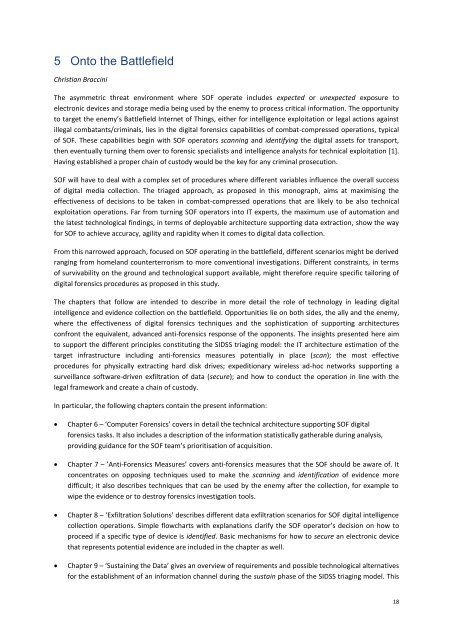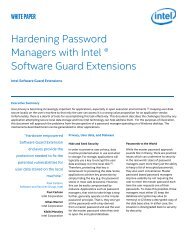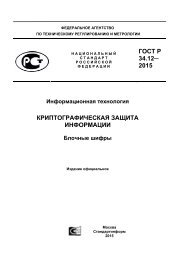BATTLEFIELD DIGITAL FORENSICS
BDF_Battlefield_Digital_Forensics_final
BDF_Battlefield_Digital_Forensics_final
Create successful ePaper yourself
Turn your PDF publications into a flip-book with our unique Google optimized e-Paper software.
5<br />
Onto the Battlefield<br />
Christian Braccini<br />
The asymmetric threat environment where SOF operate includes expected or unexpected exposure to<br />
electronic devices and storage media being used by the enemy to process critical information. The opportunity<br />
to target the enemy’s Battlefield Internet of Things, either for intelligence exploitation or legal actions against<br />
illegal combatants/criminals, lies in the digital forensics capabilities of combat-compressed operations, typical<br />
of SOF. These capabilities begin with SOF operators scanning and identifying the digital assets for transport,<br />
then eventually turning them over to forensic specialists and intelligence analysts for technical exploitation [1].<br />
Having established a proper chain of custody would be the key for any criminal prosecution.<br />
SOF will have to deal with a complex set of procedures where different variables influence the overall success<br />
of digital media collection. The triaged approach, as proposed in this monograph, aims at maximising the<br />
effectiveness of decisions to be taken in combat-compressed operations that are likely to be also technical<br />
exploitation operations. Far from turning SOF operators into IT experts, the maximum use of automation and<br />
the latest technological findings, in terms of deployable architecture supporting data extraction, show the way<br />
for SOF to achieve accuracy, agility and rapidity when it comes to digital data collection.<br />
From this narrowed approach, focused on SOF operating in the battlefield, different scenarios might be derived<br />
ranging from homeland counterterrorism to more conventional investigations. Different constraints, in terms<br />
of survivability on the ground and technological support available, might therefore require specific tailoring of<br />
digital forensics procedures as proposed in this study.<br />
The chapters that follow are intended to describe in more detail the role of technology in leading digital<br />
intelligence and evidence collection on the battlefield. Opportunities lie on both sides, the ally and the enemy,<br />
where the effectiveness of digital forensics techniques and the sophistication of supporting architectures<br />
confront the equivalent, advanced anti-forensics response of the opponents. The insights presented here aim<br />
to support the different principles constituting the SIDSS triaging model: the IT architecture estimation of the<br />
target infrastructure including anti-forensics measures potentially in place (scan); the most effective<br />
procedures for physically extracting hard disk drives; expeditionary wireless ad-hoc networks supporting a<br />
surveillance software-driven exfiltration of data (secure); and how to conduct the operation in line with the<br />
legal framework and create a chain of custody.<br />
In particular, the following chapters contain the present information:<br />
<br />
<br />
<br />
<br />
Chapter 6 – ‘Computer Forensics’ covers in detail the technical architecture supporting SOF digital<br />
forensics tasks. It also includes a description of the information statistically gatherable during analysis,<br />
providing guidance for the SOF team’s prioritisation of acquisition.<br />
Chapter 7 – ’Anti-Forensics Measures’ covers anti-forensics measures that the SOF should be aware of. It<br />
concentrates on opposing techniques used to make the scanning and identification of evidence more<br />
difficult; it also describes techniques that can be used by the enemy after the collection, for example to<br />
wipe the evidence or to destroy forensics investigation tools.<br />
Chapter 8 – ‘Exfiltration Solutions’ describes different data exfiltration scenarios for SOF digital intelligence<br />
collection operations. Simple flowcharts with explanations clarify the SOF operator’s decision on how to<br />
proceed if a specific type of device is identified. Basic mechanisms for how to secure an electronic device<br />
that represents potential evidence are included in the chapter as well.<br />
Chapter 9 – ‘Sustaining the Data’ gives an overview of requirements and possible technological alternatives<br />
for the establishment of an information channel during the sustain phase of the SIDSS triaging model. This<br />
18





